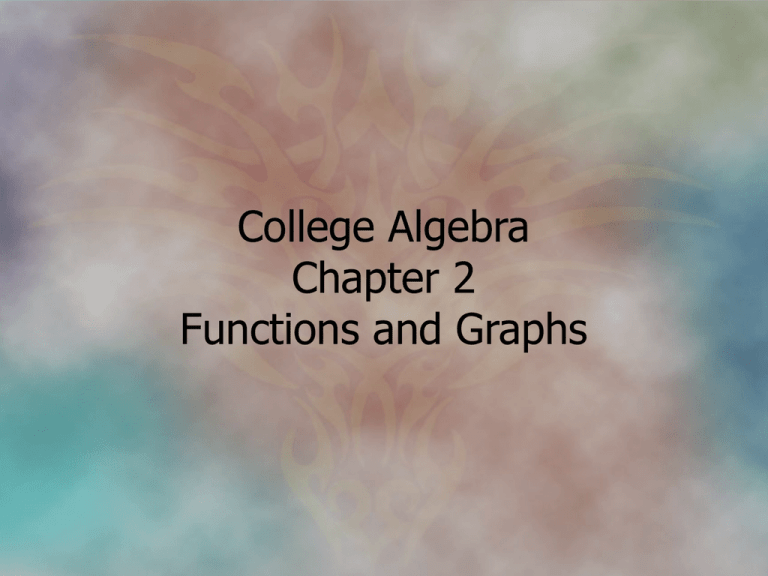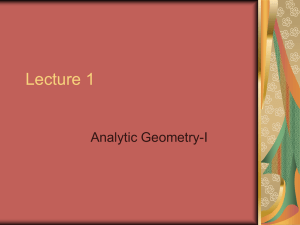Chapter 2 Powerpoint
advertisement

College Algebra Chapter 2 Functions and Graphs College Algebra Chapter 2.1 Rectangular Coordinates and the Graph of a Line Characteristics of a Linear Equation 1. Exponent on any variable is 1 2. No variable is used as a divisor 3. No two variables are multiplied together College Algebra Chapter 2.1 Rectangular Coordinates and the Graph of a Line Linear Equations Terminology Solution to a linear equation in 2 variables Any pair of substitutions for x and y that result in a true equation Input / Output Table Way to organize solutions of linear equations Rectangular coordinate system Consists of horizontal and vertical number lines Origin X axis Where the horizontal and vertical number lines intersect The horizontal number line Y axis The vertical number line Coordinate plane Two dimensional plane where functions are graphed College Algebra Chapter 2.1 Rectangular Coordinates and the Graph of a Line Linear Equations Terminology Quadrants Begin with I in upper right and move counterclockwise Gridlines / tick marks Placed on each axis to denote the integer values Coordinate grid When tick marks are extend throughout the coordinate plane Lattice points When both the x and y have integer values Y-intercept Where the graph cuts through the x axis X-intercept Where the graph cuts through the y axis College Algebra Chapter 2.1 Rectangular Coordinates and the Graph of a Line College Algebra Chapter 2.1 Rectangular Coordinates and the Graph of a Line Graph using the intercept method 2x+5y=6 3x-6y=18 -2x+y=-7 College Algebra Chapter 2.1 Rectangular Coordinates and the Graph of a Line College Algebra Chapter 2.1 Rectangular Coordinates and the Graph of a Line Graph the lines and tell where they intersect x=4 y=-2 (4,-2) College Algebra Chapter 2.1 Rectangular Coordinates and the Graph of a Line Slope Formula and Rates of Change Steepness of a line is referred to as slope vertical change Measured using the ratio horizontal change The slope triangle Slope expresses a rate of change between 2 quantities changein y y changein x x m eans" changein" College Algebra Chapter 2.1 Rectangular Coordinates and the Graph of a Line Slope Formula and Rates of Change vertical change rise y2 y1 horizontalchange run x2 x1 Result is called the slope formula College Algebra Chapter 2.1 Rectangular Coordinates and the Graph of a Line Use slope formula to calculate slope of lines that contain the following points 9,29 and 12,87 m 58 3 4,3 and 20,10 m 13 16 College Algebra Chapter 2.1 Rectangular Coordinates and the Graph of a Line Positive and Negative Slope If m>0, then y values increase from left to right If m<0, then y values decrease from left to right College Algebra Chapter 2.1 Rectangular Coordinates and the Graph of a Line Slope of horizontal and vertical lines Horizontal line m=0 Vertical line m=undefined College Algebra Chapter 2.1 Rectangular Coordinates and the Graph of a Line Slope of parallel and perpendicular lines Slope of parallel lines are equal Slope of perpendicular lines are negative reciprocals 1 m1 m2 College Algebra Chapter 2.1 Rectangular Coordinates and the Graph of a Line Midpoint formula x1 x2 y1 y2 , 2 2 Distance formula d x2 x1 y2 y1 2 2 College Algebra Chapter 2.1 Rectangular Coordinates and the Graph of a Line Calculate midpoint and distance for each set of points d (-3,-2) and (5,4) (7,10) and (-3,-10) x2 x1 y2 y1 2 2 x1 x2 y1 y2 , 2 2 College Algebra Chapter 2.1 Rectangular Coordinates and the Graph of a Line Homework pg 150 1-86 College Algebra Chapter 2.2 Relations, Functions, and Graphs Relations and mapping notation A relation is a correspondence between two sets College Algebra Chapter 2.2 Relations, Functions, and Graphs Relations and mapping notation The set of all first coordinates is called the Domain The set of all second coordinates is called the Range College Algebra Chapter 2.2 Relations, Functions, and Graphs Graph the following relation y x 2x 2 College Algebra Chapter 2.2 Relations, Functions, and Graphs Graph the following relation y 9 x 2 College Algebra Chapter 2.2 Relations, Functions, and Graphs Graph the following relation 2 x y College Algebra Chapter 2.2 Relations, Functions, and Graphs A function is a relation where each element of the domain corresponds to exactly one element of the range Vertical Line Test If every vertical line intersects the graph of a relation in at most one point, the relation is a function Domain uses vertical boundary lines Range uses horizontal boundary lines College Algebra Chapter 2.2 Relations, Functions, and Graphs Domain of rational and square root functions 3 y x2 x ,2 2, x5 y 2 x 9 x | x R, x 3,3 y 2x 3 3 x , 2 College Algebra Chapter 2.2 Relations, Functions, and Graphs Function Notation Given f x 2x 4x 5 2 find f 2 3 f 2 f 2a f a 2 College Algebra Chapter 2.2 Relations, Functions, and Graphs Homework pg 167 1-110 College Algebra Chapter 2.3 Linear Functions and Rates of Change Solving for y in linear equations ax+by=c offers advantages when evaluating When a function has been solved for y (y has been written in terms of x) it is called function form College Algebra Chapter 2.3 Linear Functions and Rates of Change A linear function of the form y=mx+b, the slope of the line is m, and the y-intercept is (0,b) Solve each equation for y, then state the slope and y-intercept 3x-2y=18 4x-y=2 College Algebra Chapter 2.3 Linear Functions and Rates of Change Finding equations when given the slope and a point 2 m 3 6,2 1 m 2 10,8 3 m 2 4,10 College Algebra Chapter 2.3 Linear Functions and Rates of Change Equations in point-slope form y y1 m x x1 Solve for y College Algebra Chapter 2.3 Linear Functions and Rates of Change Equations in point-slope form y mx x1 y1 College Algebra Chapter 2.3 Linear Functions and Rates of Change Equations of lines parallel and perpendicular College Algebra Chapter 2.3 Linear Functions and Rates of Change Write the equations of the lines parallel and perpendicular to 4 f x x 2 through 5 6,4 College Algebra Chapter 2.3 Linear Functions and Rates of Change Homework pg 182 1-114 College Algebra Chapter 2.4 Quadratic and other Toolbox Functions Characteristics of Quadratics Concavity Direction branches point, this is the end behavior (concave up or down) Axis of Symmetry Imaginary line that cuts the graph in half Vertex Highest or lowest point College Algebra Chapter 2.4 Quadratic and other Toolbox Functions Graphing factorable quadratic functions 1. Determine end behavior: concave up if a > 0, concave down if a < 0 2. Find the y-intercept by substituting 0 for x: 3. Find the x-intercept(s) by substituting 0 for f(x) and solving for x x x 4. Find the axis of symmetry h 2 5. Find the vertex h, f h h, k 6. Use these features to help sketch a parabolic graph 1 2 College Algebra Chapter 2.4 Quadratic and other Toolbox Functions Graphing factorable quadratic functions graph f x 2x 5x 3 2 1. 2. 3. 4. 5. 6. Determine end behavior: concave up if a > 0, concave down if a < 0 Find the y-intercept by substituting 0 for x: Find the x-intercept(s) by substituting 0 for f(x) and solving for x x x Find the axis of symmetry h 1 2 Find the vertex h, f h h, k 2 Use these features to help sketch a parabolic graph College Algebra Chapter 2.4 Quadratic and other Toolbox Functions Graphing factorable quadratic functions graph f x x 3x 10 2 1. 2. 3. 4. 5. 6. Determine end behavior: concave up if a > 0, concave down if a < 0 Find the y-intercept by substituting 0 for x: Find the x-intercept(s) by substituting 0 for f(x) and solving for x x x Find the axis of symmetry h 1 2 Find the vertex h, f h h, k 2 Use these features to help sketch a parabolic graph College Algebra Chapter 2.4 Quadratic and other Toolbox Functions Square root functions Always begin at a node Also called a one wing graph To graph Find the node, x-intercept, y-intercept, and an additional point College Algebra Chapter 2.4 Quadratic and other Toolbox Functions Square root functions graph f x x 2 1 To graph Find the node, x-intercept, y-intercept, and an additional point College Algebra Chapter 2.4 Quadratic and other Toolbox Functions Square root functions graph f x 2x 13 2 To graph Find the node, x-intercept, y-intercept, and an additional point College Algebra Chapter 2.4 Quadratic and other Toolbox Functions Cubing Function Have points of inflection / pivot points To 1. 2. 3. 4. 5. graph find End behavior Y-intercept x-intercepts Point of inflection Additional points College Algebra Chapter 2.4 Quadratic and other Toolbox Functions Cubing Function graph f x x3 4 x To graph find 1. End behavior 2. Y-intercept 3. x-intercepts 4. Point of inflection 5. Additional points College Algebra Chapter 2.4 Quadratic and other Toolbox Functions Cubing Function graph f x x3 x 2 4x 4 To graph find 1. End behavior 2. Y-intercept 3. x-intercepts 4. Point of inflection 5. Additional points College Algebra Chapter 2.4 Quadratic and other Toolbox Functions Cube root function Graph by selecting inputs that yield integer value outputs College Algebra Chapter 2.4 Quadratic and other Toolbox Functions Cube root function graph f x 3 x 3 College Algebra Chapter 2.4 Quadratic and other Toolbox Functions The average rate of change for a function Given that f is continuous on the interval containing x1 and x2, the average rate of change of f between x1 and x2 is given by y f x2 f x1 x x2 x1 College Algebra Chapter 2.4 Quadratic and other Toolbox Functions The average rate of change for a function Find the average rate of change for the interval 0 t 5 ht 16t 2 80t y f x2 f x1 x x2 x1 College Algebra Chapter 2.4 Quadratic and other Toolbox Functions Homework pg 200 1-84 College Algebra Chapter 2.5 Functions and Inequalities Since an x-intercept is the input value that gives an output of zero, it is also referred to as a zero of a function College Algebra Chapter 2.5 Functions and Inequalities 1 3 for g x x , solve the inequality g x 0 2 2 Meaning for what inputs is the graph above or equal to the x axis? What is the x-intercept? College Algebra Chapter 2.5 Functions and Inequalities Solving quadratic inequalities hx x 2 4x 5; hx 0 Find zeros of function Check concavity Sketch the parabola State solution College Algebra Chapter 2.5 Functions and Inequalities Homework pg 212 1-92 College Algebra Chapter 2.6 Regression Technology and Data Analysis Regression is an attempt to find an equation that will act as a model for raw data College Algebra Chapter 2.6 Regression Technology and Data Anaylsis Scatter Plots & positive / negative Association Scatter Plots & linear / nonlinear associations Strong & Weak Associations Calculating linear equation model for a set of data Linear regression and the line of best fit TI-83 College Algebra Chapter 2.6 Regression Technology and Data Anaylsis Homework pg 224 1-38 College Algebra Chapter 2 Review lines scatter-plot axis of symmetry Origin y-axis Input Vertex lattice point Node Relation zeros of a function Slope Ordered pair Intercept Range x-axis Output Function Domain parallel lines Regression perpendicular College Algebra Chapter 2 Review College Algebra Chapter 2 Review College Algebra Chapter 2 Review College Algebra Chapter 2 Review







